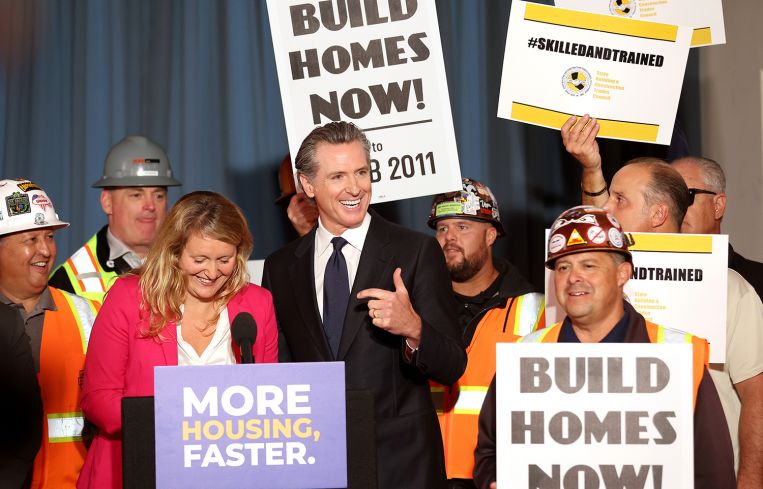California Legislature Passes New Guidance on Controversial ‘Builder’s Remedy’ Rule
Assembly Bill 1893, along with a companion bill, head to Newsom’s desk for approval
By Nick Trombola September 13, 2024 5:44 pm
reprints
California lawmakers passed a bill reforming the state’s controversial “builder’s remedy” housing provision, seeking an end to the provision’s free-for-all approach by developers and vehement opposition by dozens of localities.
If signed by Gov. Gavin Newsom, Assembly Bill 1893 would modernize and provide more guidance toward the application of builder’s remedy, formerly a little-known aspect of the state’s Housing Accountability Act passed in 1990. In its current iteration, the provision essentially allows developers to bypass local zoning restrictions in cities or localities that are not in compliance with the state’s housing goals and secure quick approvals on projects with at least 20 percent low-income units or 100 percent moderate-income units.
Builder’s remedy was barely, if at all, used for decades until it exploded on the Los Angeles real estate scene in 2022 when local developer Leo Pustilnikov attempted to use it to win approvals for projects in Redondo Beach and Santa Monica. Since then, at least 150 builder’s remedy applications have flooded California cities, most notably in wealthy enclaves like Beverly Hills, where they’ve faced fierce opposition from city councils and residents who argue the rule strips them of the ability to shape their own communities.
Yet AB 1893, introduced earlier this year by Assembly member Buffy Wicks, confirms builder’s remedy as an intended aspect of California housing law. The bill would limit the scope and density of projects attempting to use the provision, while also providing more specific protection for its use from opponents in cities that aren’t meeting state housing targets.
“The builder’s remedy is meant to hold accountable jurisdictions that do not adopt a compliant housing element on time,” state Attorney General Rob Bonta said in a statement earlier this year after announcing he was supporting the bill. “With AB 1893, we are finally updating this important provision to be clearer for local governments, planners, developers and courts, while ensuring that even cities without up-to-date housing plans continue to develop desperately needed housing that is affordable to middle-class and lower-income Californians.”
New parameters for builder’s remedy under the bill include the exclusion of project sites on or adjacent to parcels with heavy industrial use, setting site-specific density minimums and maximums, allowing jurisdictions to impose certain clear objective standards for project designs, and lowering the affordability requirements mandated for projects to claim builder’s remedy.
The bill also seeks to weaken the tactics used to block builder’s remedy-driven projects by streamlining the zoning approval process, protecting their fair treatment in approval hearings and expressly prohibiting jurisdictions from “conduct undertaken for an improper purpose that effectively disapproves [the project],” language from the bill states.
If signed by Gov. Newsom, all new builder’s remedy projects filed after Jan. 1, 2025, must meet the bill’s requirements to receive its benefits.
For current builder’s remedy projects, there will exist two options. Under the first option, projects can “convert” their specifications to meet the new requirements, and thus receive the law’s benefits, even if those changes breach the typical zoning rule that a project cannot change the amount of units or overall size by more than 20 percent and retain entitlements.
Under the second option, such projects can opt to not revise their designs to meet the law’s requirements and still fall under the original parameters of builder’s remedy, such as they are. But they will not receive protections provided under the new law.
A companion piece of legislation, AB 1886, which also recently passed both chambers of the California legislature, provides yet more protections for builder’s remedy in clarifying existing rules on state housing law compliance.
Under AB 1886, which also heads to Newsom’s desk for final approval, jurisdiction’s could not “self-certify” that their housing plans comply with state rules, and instead must have their plans certified by either the California Department of Housing and Community Development or a judge. The bill also mandates that a jurisdiction’s compliance status be tied to the date that a given builder’s remedy application was submitted, meaning that the jurisdiction cannot reject a project once its housing plan becomes compliant.
AB 1893 and AB 1886 were presented to Gov. Newsom on Sept. 12 and Sept. 11, respectively. Under California law, the governor has 12 days to sign, approve without signing, or veto a bill after its approval by both chambers.
Nick Trombola can be reached at ntrombola@commercialobserver.com.



